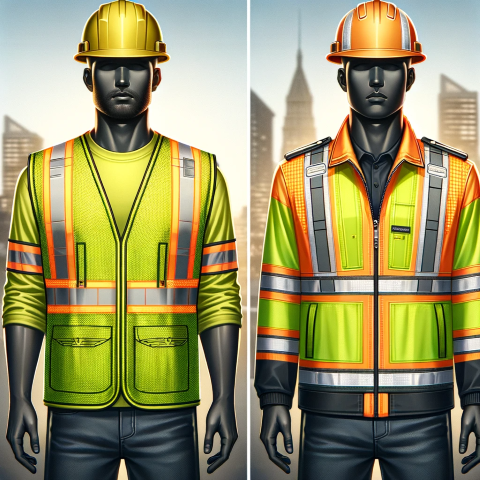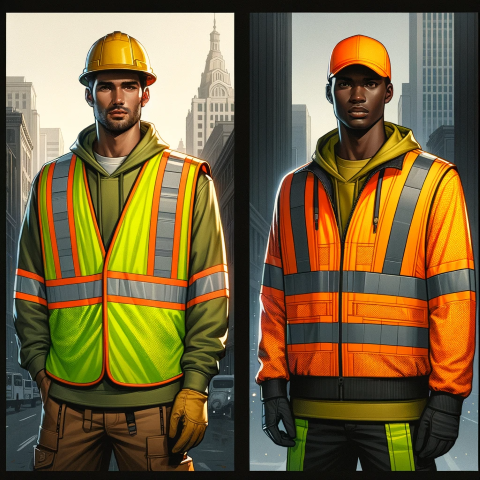Last Updated on: 25-Apr-2024 ( ago)
Share on Facebook • Share on Twitter
High Visibility Clothing Essentials: Safety, Types, and Tips
High Visibility Clothing: Unseen History to Unmissable Future
The concept of high visibility clothing (HVC) has been integral to occupational safety for decades. Its development is traced back to the high-visibility vests introduced in the Scottish Region of British Railways in 1964. Today, HVC is indispensable across various industries where visibility is paramount for safety.
Types of High Visibility Clothing
- Vests: The high visibility vest is perhaps the most recognizable form of HVC. Designed for lightweight wearability, vests can be easily donned over indoor clothes or outerwear. They commonly feature reflective strips and are available in neon colors like lime green, orange, and yellow to ensure standout visibility. Vests are a popular choice due to their ease of use, versatility, and the minimal obstruction they provide to the wearers range of motion.
- Jackets: High visibility jackets combine the reflective and fluorescent properties of a standard vest but add layers of warmth for cooler environments. These jackets can range from lightweight windbreakers to insulated winter gear, and typically include multiple pockets and protective hoods. They are essential for outdoor work in adverse weather conditions, ensuring both visibility and protection from the elements.
- Trousers: High visibility trousers are designed to ensure the wearers legs are easily seen. Like jackets, they are available in different weights to suit various climate conditions and often feature reflective taping around the legs. These trousers are critical in environments where the upper body might be obscured by barriers or equipment, ensuring full-body visibility.
- Coveralls: For full-body visibility and protection, high visibility coveralls are the garment of choice. They offer integrated high visibility solutions with the convenience of a single piece. These coveralls are used extensively in industries like chemical, oil and gas, where visibility is as crucial as protecting the body from specific hazards.
- Accessories: High visibility accessories include items such as gloves, hats, arm and leg bands, and belts. These accessories can enhance visibility and are especially useful in complex environments where any additional visibility can significantly improve safety. They can be used in conjunction with other high visibility garments or independently to provide visibility solutions tailored to specific needs.
Tips for Handling and Maintaining High Visibility Clothing
- Cleaning: To maintain the integrity of high visibility clothing, it is crucial to clean it properly. Use mild detergent without bleach to protect the fabric's luminance and reflective properties. Harsh chemicals can degrade the fluorescent material and reflective tape, reducing the garment's effectiveness.
- Drying: After washing, dry the garments on a low heat setting or hang them to air dry. High temperatures can damage the fabric and reflective materials, compromising safety features. If tumble drying is necessary, use the lowest heat setting.
- Storing: Store high visibility clothing in a clean, dry place to prevent mildew and fabric degradation. Exposure to direct sunlight for extended periods should be avoided because UV rays can fade the fluorescent colors, significantly diminishing visibility over time.
- Inspection: Regular inspection for wear and tear is vital. Look for faded colors, cracked reflective strips, and other signs of damage that could impede the clothing's visibility. These inspections should occur before each use to ensure the highest level of safety.
- Replacement: Despite proper care, high visibility clothing has a service life. Monitor the garments condition closely and replace it if it no longer meets the visibility requirements set by safety standards. Regular updating of HVC is essential to maintain compliance with safety regulations and ensure the safety of the wearer.
Profiles of Major Manufacturers or Users
- 3M: As a pioneer in the field of safety and personal protective equipment, 3M's high visibility clothing is bolstered by their expertise in producing reflective materials. Their products are designed to meet or exceed the highest standards for visibility, durability, and longevity. 3M's commitment to research and development in safety ensures that their high visibility clothing is among the most reliable in protecting workers in low-light conditions.
- Honeywell: Honeywell's safety products division extends into high visibility workwear, offering a range of garments designed for environments where being seen is critical. Their HVC gear is known for combining comfort with high-grade materials to ensure worker safety without compromising on wearability. Honeywell also emphasizes the integration of technology and safety, seeking to innovate how high visibility clothing can offer enhanced protection.
- Dickies: Dickies has a storied reputation for durable workwear and has incorporated high visibility clothing into their range. Their garments are made to withstand the rigors of demanding work environments while ensuring that workers are visible both day and night. Dickies focuses on practicality, ensuring that their high visibility apparel can be worn across different job sites and weather conditions.
- Ansell: Ansell is primarily known for its innovative protection solutions, and their venture into high visibility clothing is no exception. Specializing in protective gear, Ansell offers high visibility clothing that often comes with additional features such as flame resistance and chemical splash protection, catering to niche markets that require multifaceted protective wear.
- Carhartt: Carhartt's high visibility line adheres to the brand's reputation for tough and enduring workwear. Their HVC products are engineered to meet the needs of workers in extreme conditions, offering high visibility combined with resistance to wear and tear. Carhartt's products are a staple in industries where outerwear needs to provide visibility and withstand tough working conditions.
Applications of High Visibility Clothing
- Construction: In the bustling environment of a construction site, high visibility clothing is crucial. It ensures that workers are seen amongst heavy machinery, building materials, and the flurry of activity, reducing the risk of accidents.
- Emergency Services: For emergency personnel, being highly visible can be the difference between life and death. High visibility clothing allows them to stand out at accident scenes, during rescue operations, and in disaster management scenarios, where every second counts.
- Traffic Management: Traffic controllers and road workers wear high visibility clothing to ensure they are seen by drivers, even in poor visibility conditions. This is essential for their safety, especially in high-traffic areas or during road construction and maintenance operations.
- Warehouse Operations: High visibility clothing is important for individuals working in warehouses and logistics. It enhances the wearer's visibility in an environment filled with moving vehicles like forklifts, and in areas where the lighting may be obstructed by tall shelving.
- Outdoor Recreation: Athletes, cyclists, and outdoor enthusiasts use high visibility clothing to improve their visibility to motorists, particularly in low-light conditions or inclement weather, thereby reducing the risk of accidents.
- Maritime Activities: Personnel working on docks, ships, or near water bodies often wear high visibility clothing to ensure they can be seen easily, especially in misty or foggy conditions where the risk of falling overboard is significant.
- Airport Ground Staff: High visibility clothing is vital for ground staff working on the runways and in the apron areas of airports. It helps in distinguishing staff from their surroundings and ensures that they are seen by pilots and vehicle operators amidst the complex ground operations.
- Security Personnel: Security staff in high-traffic or crowded environments, such as concerts or public events, can be quickly and easily identified if they are wearing high visibility clothing, enabling them to respond effectively to emergencies.
- Utility Workers: For those working on or near roads, such as electricians and telecommunications engineers, high visibility clothing is important for safety. It allows other road users to see them clearly, avoiding potential hazards as they work on essential infrastructure.
- Mining: In the mining industry, high visibility clothing is key for workers who operate in dark, complex environments. It ensures workers are visible to each other and to machinery operators, reducing the likelihood of workplace accidents.
The impact of high visibility clothing within the industrial sphere and beyond cannot be understated. It is the silent guardian that stands out in the blur of activity, providing a visual cue that safeguards human lives across myriad environments. From the construction worker silhouetted against the dawn sky to the emergency responder navigating the chaos of a nighttime crisis, high visibility gear offers a beacon of safety.
In the realm of occupational health and safety, the application of HVC has become a standard from which there is no turning back. It bridges the gap between hazard and safety, becoming an integral part of the industry's DNA. Beyond its functional aspect, high visibility clothing also carries a message - a commitment to valuing human life and well-being above all. This attire has become a universal language of precaution, signaling the importance of vigilance and care in every sector it touches.
As industries evolve and the frontiers of human activity expand, the significance of high visibility clothing is only poised to grow. Its adaptation across professions and recreational activities is a testament to its indispensable role in our lives. With technological advancements, we can anticipate even greater enhancements in protective wear, ensuring that visibility, both literal and metaphorical, remains at the forefront of societal progress.
The legacy and current standing of high visibility clothing in safeguarding workers is remarkable. With continuous innovation and adherence to safety standards, HVC remains a critical element in industrial safety gear. Its evolution and persistence underscore a collective commitment to workplace safety and accident prevention, proving that visibility is not just seen but felt in the fabric of occupational health and security.
�High-visibility clothing is any clothing worn that has highly reflective properties or a color that is easily discernable from any background. Orange hunting vests are a popular example of high-visibility clothing.
Part of the surface of clothes may be made retroreflective (small parts of coats, large parts of special safety clothes for rescue workers etc.). This way they become much more visible in the dark for observers near a light source, such as the driver of a car with its headlights on. The pattern of the retroreflecting parts also helps to distinguish between objects and people.
For greater visibilty at daytime, as well as for decoration, very bright colors are obtained with fluorescence.
The opposite are clothes with a camouflage pattern.
High-visibility clothing is any clothing worn that has highly reflective properties or a color that is easily discernable from any background. Orange hunting vests are a popular example of high-visibility clothing.
Some other terms
Some more terms:
On this page
Add a definition
- The term you want to define
- Its definition in 500 words or less
- Attach an image if necessary.
- Optionally, tell us about yourself in 200 words or less!
Companies for High Visibility Clothing:
- Company name
- Company address
- Attach a logo, if necessary.
- Optionally, tell us about yourself in 200 words or less!

